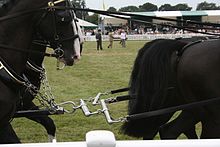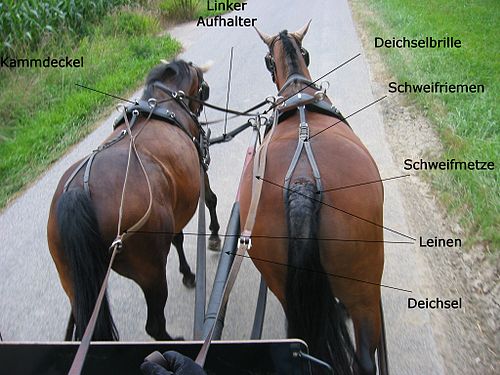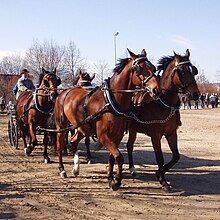Tension
In general, the configuration of a team of draft animals is referred to as tension . In a broader sense, this means the entire equipment and also the type of harness used .
Arrangement of draft animals
Horses that are additionally harnessed on particularly steep sections of the path are referred to as leader.
Pairs of horses
Pairs of horses are often used consistently together, and the space, on the left as a saddle horse or on the right as a hand horse , usually remains the same. There are several reasons for this. It takes some effort to find two horses that are well matched in terms of stride length , size, character and conformation , two so-called "passer". The horses get to know each other over time and like to work, and therefore better, together. The left saddle horse must be characterized by particular reliability in traffic, so that usually the quieter, more experienced and usually more lazy horse walks there. Often it has a little more caliber . The horse on the side facing away from traffic (hand horse) is usually the more nervous, hardworking and inexperienced animal. Even a small difference in size can be compensated, as the right horse looks a bit smaller due to the curve of the road. If the pair is always tensioned the same, then the lines do not have to be strapped differently each time.
Couples are often given matching names, such as Pepper and Salt or Bonnie and Clyde . An example of this is the poem "A Visit from St. Nicholas" (1823) by Clement C. Moore. The names of Santa Claus' eight reindeer are Dasher and Dancer , Prancer and Vixen , Comet and Cupid , Donner and Blitzen .
A horse
- Single horse (1 scissor horse )
Two horses
- Pair of horses (2 pole horses run side by side, the saddle horse on the left, the hand horse on the right)
- Biga (chariot, 2 pole horses pull with yoke on the drawbar, 2 pairs of lines)
- Tandem (2 horses in front of each other, the horse in front is the horse in front, also called the horse ahead)
Three horses
- Dreispänner (3 horses next to each other, scissors 1 horse, two outside horses, 3 line pairs)
- Troika (Russian, 3 horses side by side, 1 scissor horse, two outside horses, 4 single lines)
- Triga (3 horses side by side, 2 pole horses with yoke on the drawbar, 1 outside horse on ropes)
- Unicorn (2 pole horses, 1 front horse)
- Upside down unicorn (1 scissor horse, 2 front horses)
- Random (3 horses in front of each other)
Four horses
- Team of four (4 horses side by side, 2 pole horses on the drawbar, all horses pull on ropes)
- Quadriga (4 horses side by side, 2 pole horses pull with yoke on the drawbar, 2 outside horses on ropes)
- Four in hand (2 pole horses, 2 front horses)
Five horses
Six horses
- Six horses (2 pole horses, 2 middle horses on the central drawbar, 2 front horses)
- Wild gait (2 pole horses , 4 front horses )
Types of tension: connection of the strands to the carriage
Dock tension
Dock tension is also called fixed tension . The strands are directly connected to the car . The dock tensioner may only be used in conjunction with kumt and light wagons. The movement of the horse's shoulders is not balanced by a log, so the shoulder moves in relation to the breastplate or kumt. With this tension, the dishes inevitably rub against the shoulder.
-----o| Pferd | -----o| Wagen -----o| Pferd | -----o|
Explosive scales
The explosive device is also called a fixed bracket. The strands are connected to the trolley via a log and this in turn via a bolt . With this construction, the movement of the horse's shoulder is balanced and the breastplate or kumt does not usually rub against the shoulder. With this tension you can drive precisely, it is suitable for breaking in young horses and is used in driving sports .
-----o|| Pferd o| -----o|| Wagen -----o|| Pferd o| -----o||
Game scale
A further beam, the balance beam (horizontal log), ensures that the horses are automatically balanced if they do not pull in line. It is not so precise to drive with it, but it has proven its worth for work (see workhorse ) in agriculture . The game scale is not suitable for retraction.
-----o| | Pferd o| | -----o||_| Wagen -----o|| | Pferd o| | -----o| |
Driving styles
There are many different driving styles around the world. In Europe, Achenbach's driving style is most commonly taught and practiced, closely followed by the Hungarian driving style.
Achenbach driving style
Benno von Achenbach is the founder of the Achenbach driving style , also the German driving style. With the system one can drive one to six horses. What is important is the uniformity of tension and the harmonious harmony of the horses, the shape of the carriage, the harness and the livery. The characteristics of the Achenbach driving style are the Achenbach leash, the fixed bracket and the whip in the driver's hand. Carriages with a high driver's seat (break, coach) are popular. The lines come into the hand from above.
Country tension and Hungarian driving style

The country tension is driven with breast harness and is characterized by the Hungarian driving style. Light horses for light chariots. The wagons are not painted in color, but in natural wood, often painted with clear varnish. So all in all a simple processing.
Fittings painted black or covered with leather in the event of total tension. The breast leaves are also called slings, hence the sling harness. Achenbach leash and the German driving style, plus a stick whip , are part of the normal breastplate tension in Germany for carriage and military vehicles . Post curbs or double ring bridles are used as bits. Breastplate harnesses are only used with leather holders . Round / oval lamps are used for land tension.
Hungarian driving style
In Hungary light fast horses, called "Jucker", hence the term Juckerzug. Also in any color combination of the horses. Light, Hungarian blood horses (Jucker horses) are harnessed in light, low wagons (sand runners). Uneven tension like the itchy pull (5-horse) or the Esterhazy tension (black horse on the left, white horse on the right) are popular.
In the typical Hungarian driving style (also jerking tension ) a breastplate harness with round sewn hemp strands (inside hemp, outside leather) is used. The Hungarian harnesses have no neck belt and no small waist belt. In the original style, these dishes are decorated with scarfs and colorful ribbons and hung with bells. Schalanken are artistic wickerwork made of leather straps, which serve as a defense against flies and mosquitoes. Typical are the ornate brass buckles and linen rings, and the pillangos (rosettes made of felt).
The bridle has a movable noseband (no openings, therefore no pressure on the nasal bone) and no wire in the blind strap. The rings of the Hungarian double ring snaffle have a serrated fitting (Esterhazy snaffle). The original Hungarian tension originally included the Hungarian leash with buckles at the ends of the handles, the so-called "Viennese frogs". The lines are held together with the frogs.
The Hungarian driving style has its own handgrips and line guidance. The lines come into the hand from below. The itch whip is a wooden handle with a braided cord.
dare
Wagonette , Break, Jagdwagen , Landratswagen (like Jagdwagen, only rear bench seat lower), Marathon car, Land Vis-à-vis , Stanhope , Dogcart (with air slots), Land Dogcart (without air slots), Esterhazy car, also single-axle Dog carts
dress
Driver:
- soft hat or straw hat
- Suit - everything to match the car e.g. B. (local) costumes, uniform, riding suit without spurs
- Trestle ceiling
- brown gloves
- Women: elegant hat and costume
Co-driver:
- to match the driver's suit, with hat
- brown gloves
- Riding suit without spurs
City tension and English driving style

The English driving style, also city tension, is characterized by the English kumtan tension. If possible with heavily built, large-caliber, strong so-called body horses in front of large painted cars. Used to be driven with certain colors, corresponding to the horse colors: mold wine-red paint, foxes green and browns / blacks with dark blue cars. But dark wagons go well with all horse colors. Square lamps belong to city cars .
You can drive with the English harness on the fixed hanger or at docks . The outside horse pulls the cart into a turn. Originally, the cruising line was used, from which the German driving system with the Achenbach line developed. The crockery is made of black leather or patent leather and chrome-plated or silver or gold-colored fittings and richly plated with other decorations such as rosettes on the headrests. This is done using Liverpool, Elbow, Buxton and Tilbury curbs and the bow whip . The gentleman had arrest chains, the driver drove with leather arrestors.
A distinction is made between self-drive cars that are driven by the master and cars that are driven by the driver.
Self-drive car
Spider-, Damen-, Mail-, Demi-Mail-, Stanhope- Phaeton , Duc , Buggy , Spider (similar to Buggy), Break, Wagonette , Four-Wheel-Dogcart, Dos-à-dos , Drag (private coach), Park Coach, Doctor Chaise (Switzerland)
Single Axle: Tandemcart , sulky , gig , dog-cart , Tilbury
Coachman wagon
Coupé , Landauer , Berline , Landaulet , Halbkalesche , Vis-à-vis , Viktoria , Mylord , Omnibus , Coach, Mail-Coach (public coach), Char-à-Bancs
dress
Driver:
- gray suit, gray top hat (as the owner of the team) or dark suit and bowler hat
- Dark suit, black cylinder (employed coachman ), single-row skirt with 6 buttons at the front, 4 at the back (2 at the top of the waistband, 2 at the bottom of the skirt or on the pleats), black boots with brown cuffs and white leather pants, that 4 buttons are free over the cuffs lie
- Uniform or riding suit without spurs
- Goat blanket , brown gloves
- Women: elegant hat and costume
Co-driver:
- dark suit, black top hat or dark suit and bowler hat
- Livery with 6 buttons on the front and back evenly distributed on the pleats (color like fittings on the harness), black boots with brown gauntlets and white leather pants, that 4 buttons are exposed over the gauntlets
- Plastron , white ribbon similar to a bow instead of a tie (like the ladies in dressage riding )
- black top hat, brown gloves
- black boots with brown gauntlets and white breeches
- Riding suit with cap, boots without spurs
American driving style
The American driving style was very much influenced by the American trotting sport. Usually fast horses with extreme gaits, such as hackneys and trotters, are harnessed in light wagons and with light harness. A “swab”, a longer riding crop, is used as a whip. Typical are wagons with a long boom, e.g. B. Buggy , Runabout and Rockaway.
Russian driving style
The typical tension option in Russian tension is the troika (3 horses side by side). The middle horse (usually an Orlov tarber) trots under the duga, a wooden stirrup that connects the anzen. The two outer horses (mostly Galopins) are only loosely attached and not in the train. Thus, the position of the horses could be changed again and again, and you could cover long distances. Because the outdoor horses are only loosely attached, it is even possible for them to jump over snowdrifts and tree trunks on narrow paths. Since the long winters in Russia are very cold, thick gloves were usually worn. Holding a whip would be very impractical due to the lack of sensitivity. Therefore, metal buttons were attached to the lower side of the lines, at the level of the croup. A light, quick up and down movement of the line drove the horses on and replaced the whip aid. The harness has no buckles, just sinks.
Driving à la Daumont
The ridden team is also often used in the military. The "driver" sits on the saddle horse (left horse). He controls saddle and hand horse (right horse) from the horse. This means that the coach does not need a driver's seat (e.g .: Vis-à-Vis ). Driving à la Daumont is not allowed in the tournament and is now mostly seen at royalty.
Work stress or rural stress
Work horses are harnessed with pointed collars and play scales. With the toy scales, both horses have to pull the same amount, as a less pulling horse will fall back a little and then have to pull more again to catch up. Therefore, the toy scale is well suited for stressful work. The clothes of the driver or horse handler depend on the work that is to be performed, as well as the type of wagon (e.g. ladder cart, beer cart) or work equipment (e.g. plow). Headgear is also common when the work is intense. Cold-blooded animals are often used.
Bovine
Even cattle , especially oxen can'm tense. A yoke is often used for this.
literature
- Klaus Drawer: Tension and harnessing of pets . DLG-Verlag, Frankfurt (Main) 1959 (92 pages).
- Andres Furger: Driving skills. Man, horse and cart from 1700 until today . Olms, Hildesheim 2009, ISBN 978-3-487-08484-8 .
- Richard Lefebvre des Noëttes : La force motrice animale à travers les âges . Berger-Levrault, Paris 1924.
- Astrid Masson: Handbook cattle tension. Practical guide on the behavior, training, harnessing and tensioning of draft cattle . Strong horses publishing house, Lemgo 2015, ISBN 978-3-9808675-5-9 .
- Paul Starkey: Harnessing and Implements for Animal Traction. An Animal Traction Resource Book for Africa . Vieweg, Braunschweig / Wiesbaden 1989, ISBN 3-528-02053-9 ( animaltraction.com [PDF; accessed on January 4, 2017]).
- Friedrich Anton Zürn: Dishware or harness theory . Leipzig 1897, urn : nbn: de: bvb: 12-bsb00073026-7 .
See also
Web links
Individual evidence
- ↑ Phyllis Siefker: Santa Claus, Last of the Wild Men: The Origins and Evolution of Saint Nicholas, Spanning 50,000 Years . McFarland & Company, Jefferson, NC 1997, ISBN 0-7864-0246-6 , p. 4.
- ↑ The carriages and chassis of the Greeks and Romans and other ancient peoples Volume 1 , Johann Christian Ginzrot, Stuttgart, 1817, Chapter IV "Von dem Joche", page 46 ff and Chapter V "Of the different types of covering", page 50 ff









